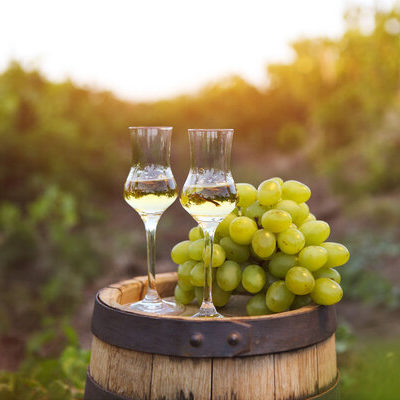
Grappa
What is Grappa?
Grappa is an alcoholic beverage, specifically a pomace brandy, crafted from a base of grapes. It is made using the skins, seeds, and leftover stems of grapes from winemaking. It is of Italian origin and has been traditionally produced in northern Italy. The drink is often served as a ‘digestivo’, or after-dinner drink in Italy, as well as in cocktails and sometimes even in coffee.
- This alcohol served on its own must be served chilled, ideally in a tulip-shaped glass.
- It has an alcohol by volume content of between 35 to 60 percent.
The top 10 most popular brands are:
- Poli Grappa Sarpa Di Poli
- Nonino Vigneti Moscato
- Piave Selezione Cuore
- Grappa Asteggiana Cristiani
- Lorenzo Inga Grappa Di Prosecco
- Candolini Ruta
- Marolo Grappa di Barolo
- Poli Grappa Miele
- Zanin Grappa Di Prosecco
- Marolo Camomile
Origin of grappa
This beverage was first invented in order to reduce waste during winemaking. While distilled spirits have a long history and origins in medieval Arabia, this alcohol is of Italian origin. It was originally prepared from a mixture of leftover grapes from different places and was usually drunk by poor people. However, in the 1960s, Giannola Nonino decided to produce this drink from a single grape source in a bid to make it of better quality. This quickly became popular and today, it is enjoyed throughout the world. Every year, Italy holds a competition called Alambicco d’Oro for the best version.
Nutrition
One shot (30 ml) contains:

Rich in different antioxidants, this can even provide some health benefits. However, the alcohol content is quite high, and hence it must be consumed in moderation. Overconsumption of alcohol, such as this, can lead to several health problems, including general lowering of immunity, liver cirrhosis, pancreatitis, high blood pressure, stroke, and different types of cancers.
Commercial production
Grappa is made with the skin of the grapes left over from winemaking. The skins already undergo fermentation during winemaking and are then sent over to the distillery to make this beverage. Skins obtained from making white wine are unfermented and, hence, must be fermented before proceeding. These skins, or pomace, have to be fresh to get the best product.
The fermented pomace is placed in copper stills, which are sealed and heated. This results in the separation of the volatile parts of the pomace, thus extracting the alcohol and the aroma. Next, the head and tail of the distilled liquid are removed. The heart of the liquid makes this drink, which is then bottled.
Bottles should always be kept in an upright position. They should be stored in a cool and dark place away from direct sunlight. Opened bottles will gradually lose their aroma, but this can be reduced by sealing them in between use.
Grappa recipes
This alcoholic beverage is a great addition to the kitchen. It can be used in cooking and baking. Also, it can be used in cocktails to bring out intense flavors. Here are a few popular recipes:
- Grapparita
- Almond Cookies
- Roast Chicken
- Espresso Martini
- Quail with Grapes
- Pears Baked
- Mushroom Chestnut Soup with Cream
- Gimlet
- Venetian Truffles
- Hot Cherries In Skillet With Ice Cream
- Apple Cake
FDA regulations
This beverage may not be produced in the US or in any other country except Italy, Switzerland, and San Marino, according to the European Union regulations. Additionally, it must be made from pomace in order to be considered grappa and there should be no water added to the mix.
References
How Grappa is Made, Local Aromas
https://www.localaromas.com/how-grappa-is-made/
Francesca, History of Grappa, Life in Italy
https://www.lifeinitaly.com/food/wines/history-of-grappa/
Carol Galbicsek, Effects of Alcohol, Alcohol Rehab Guide
https://www.alcoholrehabguide.org/alcohol/effects/
Mercolini, Laura et al. “Content of melatonin and other antioxidants in grape-related foodstuffs: measurement using a MEPS-HPLC-F method.” Journal of pineal research vol. 53,1 (2012): 21-8. doi:10.1111/j.1600-079X.2011.00967.x
https://pubmed.ncbi.nlm.nih.gov/22017461/
